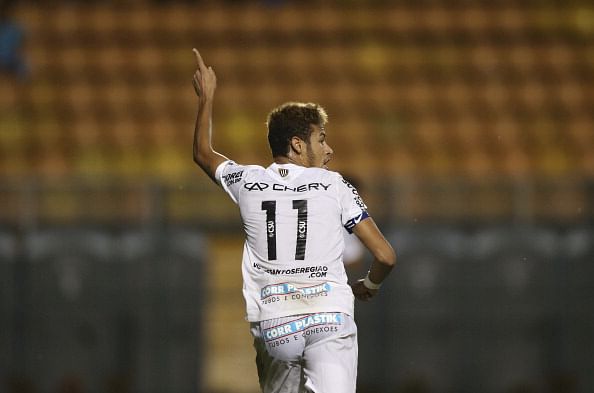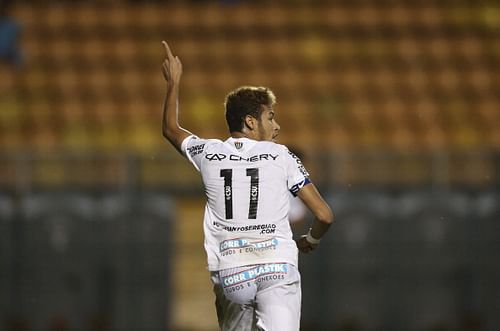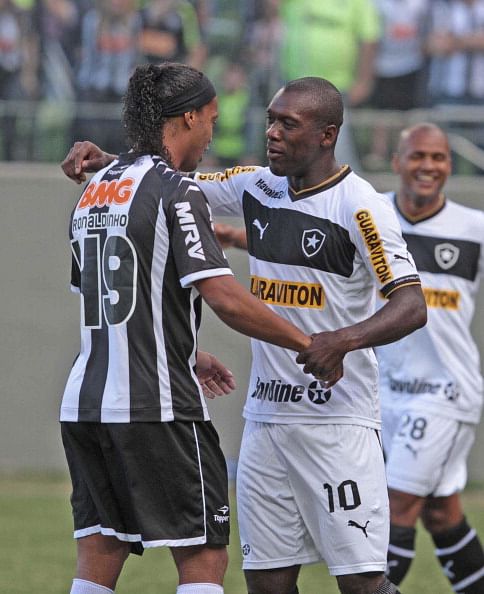
The return of the Campeonato Brasileiro

Neymar of Santos in action during a match between Santos FC and Sao Caetano as part of the Sao Paulo State Championship 2013 on April 4, 2013 in Sao Paulo, Brazil. (Getty Images)
A free-kick is awarded on the edge of the penalty area in the last minute of the match with the scores level. It’s tense. The attacking team are readying their players, both emotionally and physically, to avoid the ironic cheers of an anti-climactic punt into the great hoards of home fans cheering to will them on. The defending team, wise to their opponents’ abilities, prepare their defensive wall and get ready for the free-kick to be taken. ‘Is that wall 10-yards back?’ the referee asks himself as the wall assembles. But wait, this isn’t Europe, this is Brazil, and the referee has one of those little spray paint can thingies that he can spray on the pitch to show where the wall can stand. The problem is solved. Far from an act of vandalism (the paint isn’t permanent – phew), this is just one of the many ways in which Brazilian football is on the rise. It being Brazil, the fictional free-kick sails in as well. Bedlam. Admittedly, some linesmen do abuse the spray can privilege.
But the national league in Brazil does more than use frustrated graffiti artists as referees (promisingly, none have developed a ‘tag’). The 2013 Campeonato Brasileiro starts on May 25th as one of the most interesting, wealthiest and fastest growing leagues in the world. It has had, and is having, some ‘growing pains’ but it certainly looks likely to financially overtake some European leagues in the future, keeping them in spray paint for years to come. With economic growth theoretically back on track in Brazil, the league could dwarf even the likes of the Italian Serie ‘A’ one day as a result. The Brasileiro has been very much the little acorn of world football leagues, to use a metaphor that doesn’t quite work. The 2014 World Cup will only help of course, so we’re all told.
Before the league can ‘boom’, as strong economies are fond of doing, it really must make some real changes (economics students or South American residence/tourists may have realised this is a hilarious pun, as the ‘real’ is the Brazilian currency).
Some say Brazilian domestic football is too complex, but it really isn’t. The CBF and Brazilian sports minister, Aldo Rebelo, have recently clashed over the issue of reformation with regards to the domestic schedule however. The under-watched state leagues are something of an issue for many. Apparent of the Brasileiro, and prior to the beginning of the national league from May to December, the various state leagues run in the first half of the year and usually run from January until May. It pits local rivals against each other in 27 separate league systems depending on the states they are located in (Brazil is big). The matches are poorly attended (what must Clarence Seedorf have thought?) but because of their historical importance some are reluctant to see them omitted from the domestic calendar. Smaller clubs also like the idea of ticket income from playing the bigger teams, and who can blame them? The state leagues serve very little financial purpose to the big teams in the country however. For them it’s as important as an elongated Community Shield.

Ronaldinho of Atletico MG greets Seedorf of Botafogo during a match as part of the Brazilian Championship in 2012. (Getty Images)
They are in a bit of a ‘state‘(pun intended), and they remove key opportunities for Brazil to make its domestic league stronger in terms of finance and quality. Most tellingly, it removes the scope to align the national championship with the western European August/September to May/June calendar. As a result, as soon as the transfer market opens in Europe, the Brazilian teams are pillaged mid-season. It disrupts the national league terribly, and usually lowers the standard. You know those season preview guides that you get with the Premier League, that show the ins and outs of the transfer dealings, fixtures and squads of each team? Brazilian papers have to publish two each year.
Brazilian football is doing well, and thankfully more and more players are staying at home. A number of players with large salaries play in the country, which is the best indication of a moneyed league. With regard to this seasons Brasileirão, we should be in for a treat.
Reigning champions Fluminense will travel to Atletico Paranaense on the opening weekend, giving us time to get used to Fred as the ex-Lyon forward and current Fluzão captain looks set to start in the 2013 Confederations Cup. Fluminense look likely not to have Deco as part of their opening day squad, after he failed a drugs test this month and presumably awaits a ban. The other opening day fixture on the Saturday is Vitoria vs. Internacional where new manager Dunga may be looking to get the best out of Leandro Damião before he leaves.
The next day, Sunday May 26th, sees the full round 1 complete. In a display of the rising internal domestic transfer market, Cruzeiro have bought Dede from Vasco da Gama, and he should make his debut when they play Goias. Other games include world champions (and that is a big deal) Corinthians, with Alexandre Pato, against Seedorf’s Botafogo and Neymar’s Santos take on Flamengo, who have just sold Bebeto’s son to Juventus.
The winner of the league tends to be the squad who can best manage a number of external factors, some avoidable and some not. The scent of euros still stings the nostrils of the Brazilian-based players, and despite the money in the national league at the moment many inevitably leave. Between this, extended Copa Libertadores participation, and players leaving for international duty, a true reflection of the league won’t emerge for some time.
For 3rd and final parting pun, you’d have to be (Brazil) nuts not to watch it, if only to train your body for the time difference when the World Cup arrives in 2014.